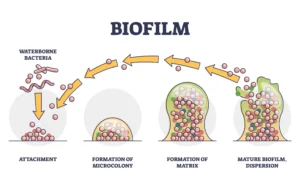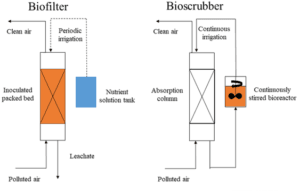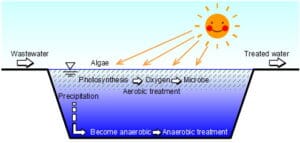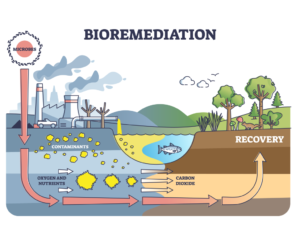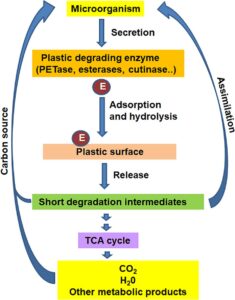Fixed film technologies are wastewater treatment methods where microorganisms grow on a stationary surface (a “film”) and treat wastewater as it flows over or through these surfaces. These technologies are widely used due to their simplicity, cost-effectiveness, and high efficiency in organic pollutant removal.

1. Trickling Filters (TFs):
Description:
- Wastewater is distributed over a bed of porous media (rocks, plastic, or other materials) covered with a biofilm of microorganisms.
- As wastewater trickles down through the media, the biofilm degrades organic pollutants.
Key Features:
- Media: Rocks, plastic, or synthetic materials.
- Aeration: Passive (air flows naturally through the filter).
- Maintenance: Low.
- Applications: Small to medium-sized wastewater treatment plants.
Advantages:
- Simple design and operation.
- Low energy requirements.
- Resistant to shock loads.
Disadvantages:
- May require a secondary clarifier to remove sloughed biofilm.
- Limited flexibility in handling high-strength wastewater.

2. Rotating Biological Contactors (RBCs):
Description:
- A series of circular discs mounted on a horizontal shaft partially submerged in wastewater.
- The discs rotate slowly, alternately exposing the biofilm to wastewater and air.
Key Features:
- Media: Discs made of plastic or other lightweight materials.
- Aeration: Passive (provided during rotation).
- Applications: Small-scale and decentralized wastewater treatment.
Advantages:
- Compact and space-efficient.
- Good oxygen transfer efficiency.
- Reliable and low operational costs.
Disadvantages:
- Sensitive to low temperatures.
- Limited to low to medium organic loads.
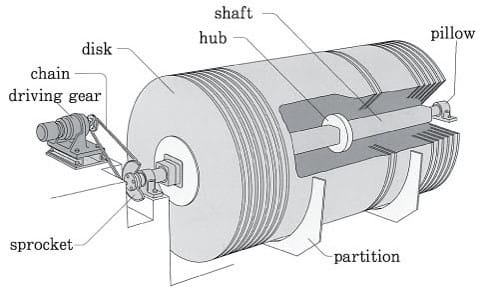
3. Moving Bed Biofilm Reactor (MBBR):
Description:
- Utilizes free-floating plastic carriers with high surface area for biofilm attachment.
- Carriers are kept in suspension by aeration or mechanical mixing within the reactor.
Key Features:
- Media: Plastic carriers with a large surface area.
- Aeration: Mechanical or air diffusers.
- Applications: Municipal and industrial wastewater treatment.
Advantages:
- High treatment efficiency in a small footprint.
- Resistant to shock loads and variable flow rates.
- Easy to retrofit into existing treatment plants.
Disadvantages:
- Requires energy for aeration or mixing.
- Periodic maintenance of carriers may be needed.

4. Integrated Fixed Film Activated Sludge (IFAS):
Description:
- Combines conventional activated sludge (suspended growth) with fixed biofilm on carriers or media.
- Enhances biomass concentration and treatment efficiency.
Key Features:
- Media: Fixed or free-floating media added to aeration tanks.
- Aeration: Mechanical or air diffusers.
- Applications: Upgrading existing activated sludge plants.
Advantages:
- High capacity and flexibility.
- Can handle higher organic loads.
- Ideal for plant upgrades with space constraints.
Disadvantages:
- Requires additional aeration.
- High initial cost for media.

5. Submerged Aerated Filters (SAFs):
Description:
- Wastewater flows through a submerged bed of media where biofilm forms.
- Air is diffused through the bed to supply oxygen for aerobic processes.
Key Features:
- Media: Inert materials like plastic, gravel, or ceramic.
- Aeration: Air diffusers supply oxygen.
- Applications: Small-scale treatment systems and package plants.
Advantages:
- Compact design.
- High oxygen transfer efficiency.
- Low sludge production.
Disadvantages:
- Requires energy for aeration.
- Potential for clogging if not maintained.
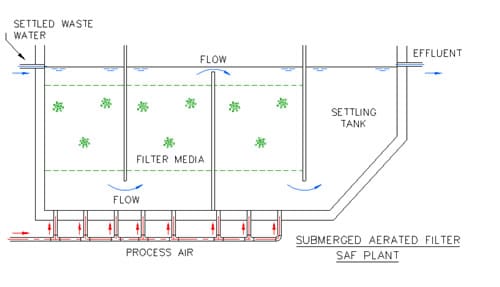
6. Packed Bed Reactors (PBRs):
Description:
- Similar to trickling filters but typically use engineered media packed into a reactor.
- Wastewater flows either downward (gravity-driven) or upward (pumped).
Key Features:
- Media: Plastic, ceramic, or other synthetic materials.
- Aeration: Passive or active, depending on flow direction.
- Applications: Industrial and high-strength wastewater treatment.
Advantages:
- High efficiency in organic load removal.
- Minimal maintenance.
- Adaptable to various wastewater types.
Disadvantages:
- Limited by hydraulic capacity.
- May require pre-treatment for high solids content.

Comparison of Fixed Film Technologies:
| Technology | Organic Load Capacity | Footprint | Energy Requirement | Maintenance | Applications |
|---|---|---|---|---|---|
| Trickling Filters (TFs) | Low to Medium | Medium | Low | Low | Municipal wastewater |
| Rotating Biological Contactors (RBCs) | Low to Medium | Compact | Low | Low | Small-scale treatment |
| Moving Bed Biofilm Reactor (MBBR) | Medium to High | Compact | Moderate | Moderate | Industrial wastewater |
| Integrated Fixed Film Activated Sludge (IFAS) | High | Medium | Moderate to High | Moderate | Plant upgrades |
| Submerged Aerated Filters (SAFs) | Medium | Compact | Moderate | Moderate | Decentralized systems |
| Packed Bed Reactors (PBRs) | High | Compact | Low to Moderate | Low | Industrial treatment |
Fixed film technologies offer robust solutions for wastewater treatment, catering to varying organic loads, space availability, and operational constraints. Selection depends on specific treatment goals, scale, and economic considerations.

